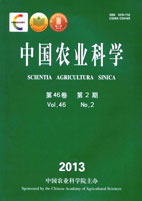-
Relationship Between the Source and Sink of Spring Maize with High Yield
- WANG Yong-Hong, WANG Ke-Ru, ZHAO Ru-Lang, WANG Kai, ZHAO Jian, WANG Xi-Mei, LI Jian, LIANG Ming-Xi, LI Shao-Kun
-
Scientia Agricultura Sinica. 2013, 46(2):
257-269.
doi:10.3864/j.issn.0578-1752.2013.02.005
-
 Abstract
(
917 )
Abstract
(
917 )
 PDF (711KB)
(
1317
)
PDF (711KB)
(
1317
)
 Save
Save
-
References |
Related Articles |
Metrics
【Objective】 Clearifing the relationship between the source and sink characteristics and the quantitative traits of spring maize with high yield (15 000 kg•hm-2) and to reveal the regulation of the source, sink and yield at different densities.【Method】Four experimental sites in maize regions with high yield of Xinjiang and Ningxia of China with similar climatic characteristics were set up (The 71st groups of the Fourth Agricultural Divisions of Xinjiang, the Qitai Farm of the Sixth Agricultural Division of Xinjiang, the experimental farm of Ningxia University, the Tongxin County of Ningxia). The resistant, density tolerance, high-yielding variety Zhengdan-958 was planted in accordance with the uniform cultivation and management practices. The treatments include 12 densities (15 000 to 180 000 plant/hm2) in order to create different types of source and sink, different yield levels (>15 000 kg•hm-2), the characteristics of the material production of maize, the maximum leaf area index (LAI), photosynthetic potential, grain weight per plant, single-grain number, harvest index, the ratio of grain to leaf, sink features, and their interrelationship.【Result】The high-yield maize dry matter accumulation and grain yield showed a quadratic function, 15 000 kg•hm-2 maize dry matter accumulation was 24 937-54 895 kg•hm-2, 19 270 kg•hm-2 (the highest yield) of dry matter accumulation of 37 417 kg•hm-2, pre-anthesis and post-anthesis accounted for 44.31% and 55.69%, respectively. The high yield maize production and maximum LAI, LAD showed a quadratic function relationships. The maximum LAI of the above 15 000 kg•hm-2 was 3.9-11.4, photosynthetic potential was 113 401-502 703 m2•d, LAI and LAD of the highest yield of maize were 6.88 and 348 142 m2•d. The yield and ear weight per plant had a negatively significant correlation (r =0.7188**), ear weight per plant of maize with the yield above 15 000 kg•hm-2 was 95.5-289.6 g, the highest yield of ear weight per plant was 169 g, yield and kernel number showed a function of quadratic relationship of maize with 1 5000 kg•hm-2 yield, the kernel number was 366.6-545.9. The kernel number of the highest yield of maize was 469. The yield and weight of kernel showed a quadratic function relationships. The 1000-kernels-weight was 232.6-388.6 g, the 1000-kernel-weight of maize with the highest yield was 361.0 g. The high yield maize production and harvest index had a quadratic function relationship, the harvest index was 31.5-61.9%, while that of the highest yield was 51.5%. The yield and kernel number/leaf area and kernel number/leaf dry weight was not significantly correlated (rkernel number/leaf area=0.1520, rkernelr/leaf dry weight =0.2577), the kernel weight/leaf dry weight was significantly (r=0.5847*) and had a quadratic relationship, the kernel weight/leaf weight was 1.1-7.13, kernel weight/leaf area was 149.4-506.5 g•m-2, the highest yield of kernel-leaf ratio was 5.39 and 366.4 g•m-2 of maize with yield above 15 000 kg?hm-2.【Conclusion】At different yield levels, the proportion of dry material accumulation and the photosynthetic potential existed difference in pre-anthesis and post-anthesis, the higher yield needs higher dry matter accumulation and photosynthetic potential, and the higher dry matter accumulation at pre-anthesis, the higher the proportion of photosynthetic potential at post-anthesis, As Zhengdan-958 is a type of source deficiency, which is a main limiting factor of production in low-density, so increasing the density could improve yield. The primary mechanism of yield is increase of leaf source. The high-density conditions, the source and sink increased at the same time but the increased proportion of the relative lack of sink was the main limiting factor of production, the main mechanism of yield increase improved seed setting rate and increased grain weight by the sink expansion methods.









